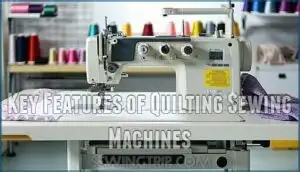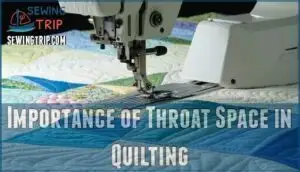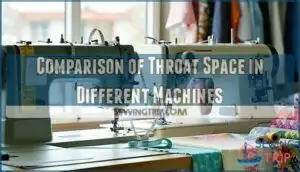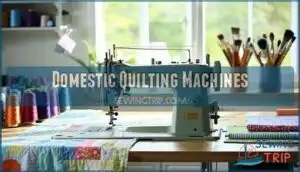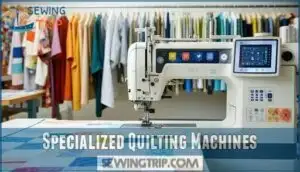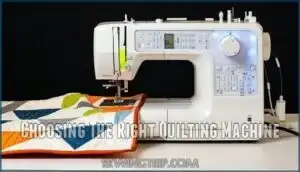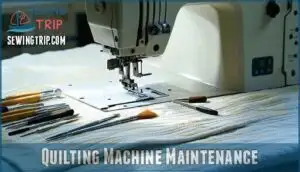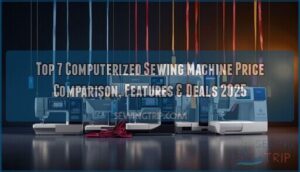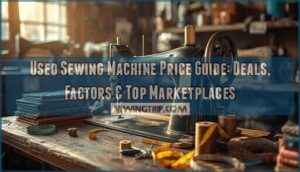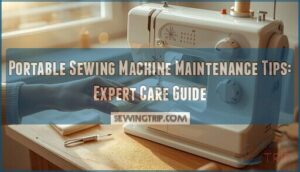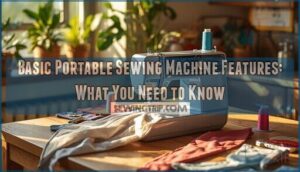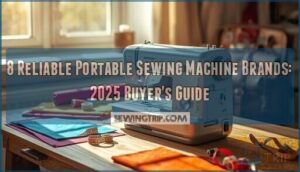This site is supported by our readers. We may earn a commission, at no cost to you, if you purchase through links.
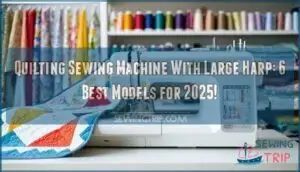 If you’re quilting, you know the struggle of cramming a large quilt through a tiny machine throat—it’s like trying to fit a blanket into a toaster.
If you’re quilting, you know the struggle of cramming a large quilt through a tiny machine throat—it’s like trying to fit a blanket into a toaster.
That’s where a quilting sewing machine with a large harp shines. The spacious throat space, like in the Juki HZL NX7 or Janome MC6650, helps you manage bulky layers without breaking a sweat.
It keeps your stitches smooth, your fabric flat, and your sanity intact. Look for features like precision stitching, speed control, and a sturdy build.
Once you’ve tried one, you’ll wonder how you ever quilted without it. The right choice makes all the difference!
Table Of Contents
Key Takeaways
- You’ll need a sewing machine with at least 9 inches of throat space to handle bulky quilting projects smoothly.
- Choose machines like the Juki HZL NX7 or Janome MC6650 for large throat space, professional stitch quality, and durability.
- Focus on features like adjustable stitch settings, automatic needle threaders, and multiple presser feet for a hassle-free quilting experience.
- Regular maintenance, like cleaning lint and oiling, keeps your quilting machine running smoothly and extends its lifespan.
Large Throat Sewing Machines
You’ll need a large throat sewing machine when you’re wrestling with bulky quilts or large fabric pieces that bunch up around the needle.
Machines with 9 inches or more of throat space between the needle and body give you ample room to maneuver your quilt without feeling like you’re stuffing it through a mailbox, which provides a more comfortable sewing experience with bulky quilts.
When tackling bulky quilts, a 9-inch or larger throat space transforms your sewing experience from cramped to comfortable.
Key Features of Quilting Sewing Machines
A well-equipped quilting machine transforms your creative journey.
You’ll need a large harp (throat space) for fabric handling, adjustable stitch settings for various materials, and multiple presser feet for different techniques.
An automatic needle threader saves your eyesight, while higher sewing speeds (1,000-1,600 SPM) boost productivity.
Many models also offer enhanced product features for a smoother quilting experience.
Look for machines with extension tables and bright lighting—your shoulders will thank you during those marathon quilting sessions!
Importance of Throat Space in Quilting
Why does throat space matter so much in quilting?
When you’re wrestling with bulky quilts, the throat space (or harp) determines your fabric maneuverability.
Larger throat space lets you handle bigger project sizes with less bunching and frustration.
You’ll experience improved stitching comfort and ergonomic benefits as you work.
A quilting machine with large harp reduces quilting complexity, especially for king-sized projects that would otherwise require constant fabric rolling and adjustment.
Comparison of Throat Space in Different Machines
Looking at sewing machine throat space measurements reveals significant differences across models.
Throat space shapes your quilting freedom, transforming cramped struggles into effortless creativity with room to maneuver bulky projects seamlessly.
You’ll find the Husqvarna Viking Designer Epic offers 12.2" of quilting freedom, while vintage Singer machines range from 6" to 7.25" from needle to column.
- Modern quilting machines prioritize larger throat space for better project size capacity
- The Frister+Rossmann 800 series provides impressive 34 sq. inch harp space
- Machine size impact varies by brand, with throat dimensions directly affecting ergonomic considerations
Choose wisely for your specific needs!
Quilting Machine Types
You’ll find three main quilting machine types to evaluate for your projects: long-arm models for professional work, domestic machines for home use, and specialized models with features suited to specific quilting techniques.
Each type offers different harp sizes, speed capabilities, and specialized functions that can substantially impact your quilting experience and results.
Long-Arm Quilting Machines
When you’re ready to tackle larger quilting projects, long-arm quilting machines offer unmatched workspace with harps extending 10-16 inches or more.
These specialized systems mount on Frame Systems for quilting automation and smooth fabric loading.
Unlike domestic machines, longarm machines feature Stitch Regulation technology for consistent stitches across expansive surfaces.
Though they require more space and maintenance needs are higher, they’re the professionals’ choice for quilting freedom. Many models also offer Q-matic automation for enhanced precision.
Domestic Quilting Machines
Domestic quilting machines bridge the gap between standard sewing machines and professional long-arm models.
They’re designed with larger harps than regular machines but remain compact enough for home use. You’ll appreciate their portability options and manageable learning curve.
While they offer excellent space requirements for most projects, they typically produce moderate noise levels.
Many retailers offer a variety of quilting machine products. Budget considerations range from $500-$2,500, making machine quilting accessible for home enthusiasts with a manageable learning curve and excellent space requirements.
Specialized Quilting Machines
While domestic machines handle everyday quilting needs, specialized quilting machines take your craft to new heights.
These powerhouses combine industrial-grade technology with user-friendly features.
You’ll find computerized models offering touch-screen controls and pre-programmed quilting patterns alongside machines with remarkable throat space designed specifically for free-motion work.
With stitch regulation, specialized presser feet, and speeds reaching 1,600 stitches per minute, these machines transform complex projects into manageable masterpieces.
Top 6 Quilting Sewing Machines
You’ll find our carefully selected top 6 quilting machines with spacious harps that make handling large projects much easier and more comfortable.
These models offer the perfect combination of throat space, speed, and specialized features to help you tackle everything from simple projects to intricate quilts without the frustration of cramped working conditions.
1. Juki HZL NX7 Quilting Sewing Machine
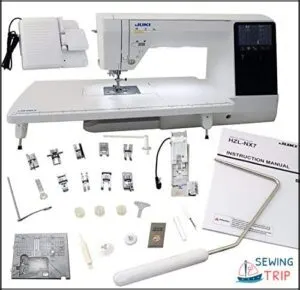
The Juki HZL NX7 stands as a powerhouse in the quilting world with its impressive 12-inch throat space that gives you plenty of room to maneuver larger quilts.
Priced at $3,299, this computerized machine features 351 stitch patterns, 4 fonts, and a user-friendly touchscreen interface.
You’ll appreciate the built-in walking foot, thread trimming capability, and JUKI Smart Feed system that guarantees professional-quality stitches.
While some users report issues with the thread cutter and needle threader durability, its smooth, quiet operation makes it ideal for intermediate to advanced quilters.
Best For: Experienced quilters and advanced sewing enthusiasts seeking a computerized machine with ample throat space and professional-quality stitches.
- Wide 12-inch throat space perfect for large quilting projects.
- 351 stitch patterns and 4 fonts for creative versatility.
- Smooth, quiet operation with professional-quality results.
- Priced higher at $3,299, which may not suit all budgets.
- Reported durability issues with thread cutter and needle threader.
- Limited servicing options due to computerized components.
2. Brother PQ1500SL Quilting Sewing Machine
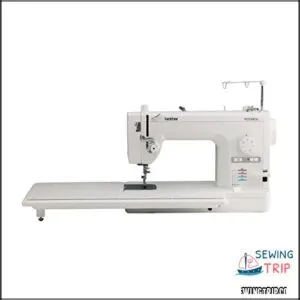
Boasting incredible speed and precision, the Brother PQ1500SL stands out with its impressive 1,500 stitches per minute capability.
You’ll appreciate the generous 8.6" throat space that accommodates larger quilting projects with ease.
The machine features an adjustable pin feed mechanism and four feed dog settings for superior fabric control across various thicknesses.
With its semi-industrial construction, automatic needle threader, and jam-resistant drop-in bobbin, this workhorse delivers professional results consistently.
The included extension table, knee lifter, and seven specialized presser feet make this a complete quilting package backed by Brother’s lifetime technical support.
Best For: Experienced sewists and quilters who need high-speed performance and precision for large or complex projects.
- Limited to 120 volts, restricting use outside the US.
- Not beginner-friendly due to advanced features and speed.
- Noise level and weight details are not specified.
- High-speed stitching at 1,500 stitches per minute for fast sewing and quilting.
- Adjustable pin feed mechanism and feed dog settings for excellent fabric control.
- Includes wide table, knee lifter, and multiple presser feet for versatility.
3. Janome MC6650 Sewing Quilting Machine
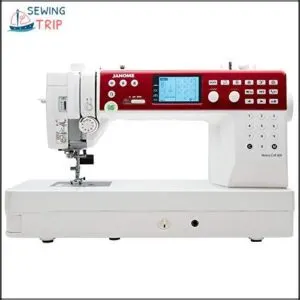
The Janome MC6650 stands as a powerhouse among quilting machines with its generous 10" all-metal seamless flatbed.
You’ll appreciate its 170 stitches plus 2 alphabets, giving you plenty of creative options. With 1,000 stitches per minute and convenient features like the superior needle threader and one-push needle plate conversion, your quilting projects will move along smoothly.
The 6 LEDs in 3 locations illuminate your work perfectly, while the automatic thread cutter saves time. Though some users report occasional issues with the thread cutter, most praise its quiet operation and sturdy construction.
Best For: Quilters and sewing enthusiasts looking for a durable, high-performance machine with advanced features for complex projects.
- Some users report occasional issues with the thread cutter.
- May skip stitches under certain conditions.
- Heavier design at 24.2 pounds, less portable.
- Spacious 10" all-metal flatbed for large projects.
- 170 stitches and 2 alphabets for creative versatility.
- Superior needle threader and automatic thread cutter for convenience.
4. Juki DX-4000QVP Sewing Machine Professional Quality
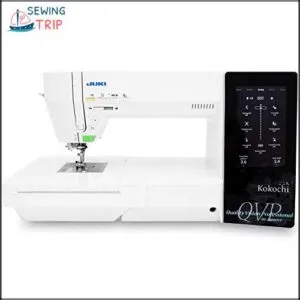
Looking for professional quilting quality? The Juki DX-4000QVP delivers with its impressive 12" throat space, perfect for maneuvering large quilts with ease.
This powerhouse features a 7" touchscreen with WiFi connectivity, 368 stitch patterns, and 6 fonts to personalize your projects. You’ll appreciate the helpful bobbin thread alert system that prevents unexpected stops mid-seam.
Juki machines are known for their industrial-grade durability, ensuring longevity. While the $6,599 price tag reflects its professional-grade status, serious quilters will find the spacious sewing area and advanced features worth the investment for tackling even the most ambitious quilting projects.
Best For: Professional quilters and sewing enthusiasts who need advanced features, a spacious work area, and durability for heavy-duty projects.
- Spacious 12" throat space ideal for large quilts.
- 7" touchscreen with WiFi and 368 stitch patterns for customization.
- Durable construction designed for long-lasting performance.
- High price point at $6,599 may not suit all budgets.
- Reports of thread tension issues and thread cutter malfunctions.
- Mixed feedback on customer service and warranty support.
5. Janome Horizon 8200QCP Sewing Machine
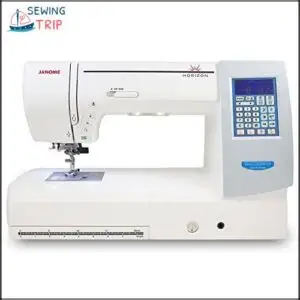
When you’re ready to step up your quilting game, the Janome Horizon 8200QCP delivers impressive performance with its generous 11-inch throat space.
This computerized machine features an intuitive LCD display, automatic thread cutter, and adjustable speed control—perfect for maneuvering large quilts with ease.
The built-in AcuFeed system guarantees precise fabric feeding while handling everything from delicate fabrics to thick denim.
With a powerful yet quiet motor and speeds up to 1000 stitches per minute, you’ll complete projects faster without sacrificing quality.
It’s a reliable workhorse that’s worth the investment.
Best For: Quilters and sewing enthusiasts who need a reliable, high-performance machine with ample throat space for larger projects.
- Generous 11-inch throat space ideal for large quilts and home furnishings.
- Built-in AcuFeed system for precise fabric feeding on various materials.
- Powerful motor allowing up to 1000 stitches per minute with quiet operation.
- Sensitive to needle and fabric types, requiring careful setup.
- Mixed reviews on the performance of the bobbin winder and walking foot.
- High price point with potential additional costs for accessories like a table extension.
6. JUKI HZL F300 Sewing Machine
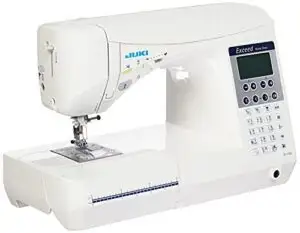
The JUKI HZL F300 stands out from the crowd with its industrial-quality performance in a home machine package.
This computerized workhorse features 106 stitches, including 16 professional buttonholes and 3 lettering fonts.
You’ll appreciate the drop-in bobbin system and automatic thread cutter that save precious time during projects.
What makes it perfect for quilting is its ability to handle multiple fabric layers with ease, and the adjustable presser foot pressure guarantees beautiful results regardless of material thickness.
At 25 pounds, it’s substantial yet portable enough for quilting retreats.
Best For: Home sewists and professionals looking for a heavy-duty, versatile sewing machine for quilting, garment construction, and complex projects.
- Higher price point compared to basic machines.
- Presser foot extender tray can be difficult to find.
- May require servicing over time, adding to long-term costs.
- Handles multiple fabric layers and challenging materials with ease.
- Includes 106 stitch options, 16 buttonholes, and 3 fonts for versatility.
- Drop-in bobbin system and automatic thread cutter save time.
Choosing The Right Quilting Machine
You’ll need to take into account the harp size, stitch quality, and speed when selecting a quilting machine that matches your specific projects.
The right machine will provide enough throat space to handle larger quilts while offering consistent stitch performance across various fabric types.
Factors to Consider When Buying a Quilting Machine
Now that you’ve seen the top machines, let’s focus on what matters when shopping for your quilting companion.
When buying a quilting machine, consider throat space first—it determines the size of quilts you can handle.
Check brand reputation and user reviews for reliability. Don’t overlook machine weight if you’ll move it often.
Balance your budget considerations with must-have features like stitch options and automated functions.
Importance of Stitch Quality and Speed
Now that you’ve sorted through your options, let’s talk about what makes your quilts shine.
Stitch quality and speed aren’t just specs on a box—they’re your quilting foundation.
Your quilting machine needs consistent stitches that don’t pucker your fabric.
Speed control matters too—you’ll want flexibility between 1,000-1,600 stitches per minute for detailed work and faster progress on larger projects.
Proper tension settings guarantee your thread doesn’t break or loop, which is crucial for achieving high-quality stitches with consistent stitches.
Role of Presser Feet in Quilting
Every quilting machine requires the right presser feet to tackle your projects effectively.
Your walking foot prevents fabric layers from shifting, while free-motion feet let you quilt in any direction.
Specialized feet like the quarter-inch foot guarantee precise seams essential for professional-looking quilts.
Understanding the function of the blind stitch foot can also greatly expand your creative options.
Don’t overlook presser foot pressure adjustments—they’re vital for proper fabric feed, especially when working with multiple layers in your large throat space machine.
Quilting Machine Maintenance
You’ll need to properly maintain your large-harp quilting machine to guarantee it continues performing at its best for years to come.
Regular cleaning, oiling, and prompt troubleshooting of issues will protect your investment and keep your quilting projects running smoothly.
Regular Maintenance for Optimal Performance
Now that you’ve selected your perfect quilting machine, let’s talk maintenance. Your large harp sewing machine needs regular TLC to keep purring along.
Clean lint from the bobbin area after each project, oil mechanisms monthly according to your manual, replace needles every 8 hours of sewing, and check tension adjustments when switching fabrics.
For computerized models, don’t forget software updates. Regular sewing machine oiling is also vital for smooth operation.
Proper quilting machine maintenance extends its life and helps those beautiful stitches keep flowing.
Troubleshooting Common Quilting Machine Issues
Now that you’ve established a maintenance routine, let’s tackle those pesky issues that pop up when you least expect them.
Even the best quilting machines with large throat space occasionally hiccup.
When your machine acts up, start with these three common culprits:
- Thread Tension Problems – Uneven stitches often mean your tension needs adjusting
- Needle Issues – Bent or dull needles cause skipped stitches and fabric damage
- Bobbin Troubles – Improper winding leads to uneven fabric feeding
Upgrading and Customizing Quilting Machines
Now that you’ve mastered troubleshooting, let’s look at how upgrading your quilting machine can transform your crafting experience.
Upgrading your quilting machine doesn’t just fix problems—it opens new creative doors. You’ll handle larger quilts with ease when you invest in machines with expanded throat space and enhanced features.
Many users find value in machine enhancement options for their quilting projects.
| Upgrade Type | Benefit | Popular Options |
|---|---|---|
| Ergonomic Modifications | Reduced fatigue | Adjustable handles, custom tables |
| Software Enhancements | Advanced designs | QCT 6 PRO, SmartStitch |
| Aftermarket Accessories | Expanded capabilities | LED lighting solutions, motor upgrades |
Frequently Asked Questions (FAQs)
What is a large throat sewing machine for quilting?
A large throat sewing machine gives you extra workspace between the needle and machine body, making quilts, bulky fabrics, and intricate designs easier to manage.
It’s like having a roomy desk for your creative projects.
What is a harp size on a sewing machine?
A harp size, or throat space, measures the area between the needle and the sewing machine’s body.
It’s essential for quilting, allowing you to maneuver bulky fabrics or large quilts with ease.
Which sewing machine has the largest throat?
The Sweet Sixteen by HandiQuilter boasts the largest throat size, offering a roomy 16 inches of harp space.
It’s a dream for handling quilts and bulky projects, giving you plenty of workspace to thrive, with the 16 inches of space being particularly noteworthy.
What are the perks of a large throat quilting machine?
In the context of quilting, a large throat space is a game-changer.
You’ll enjoy handling bulky quilts with ease, better stitch accuracy, and more freedom to work without constantly repositioning your fabric.
What is the difference between a standard and a large throat sewing machine?
A standard sewing machine offers limited space for bulky projects, but a large throat machine gives you extra room to maneuver fabric effortlessly.
It’s like upgrading from a cramped desk to a spacious workbench!
Why should you buy a large throat sewing machine?
Big projects need big space, and a large throat sewing machine gives you just that.
Maneuver quilts smoothly, avoid fabric bunching, and transform tedious tasks into stress-free stitching—all without wrestling your masterpiece!
What is the harp space on a sewing machine?
The harp space, or throat space, is the area between the needle and the machine’s body.
It determines how much fabric you can maneuver, especially helpful for large projects like quilting or sewing curtains, which can be considered a complete concept in understanding the utility of the harp space.
What is the alternative to a long arm quilting machine?
If you’re looking for an alternative to a long-arm quilting machine, try a domestic sewing machine with a large harp space.
It’s versatile, saves space, and handles big quilting projects with ease.
Why are Juki sewing machines so expensive?
Did you know Juki machines can sew 1,500 stitches per minute?
Their precision, durability, and high-end features, like industrial-grade performance and automatic thread trimming, justify the price.
They’re built to last and handle demanding projects effortlessly, making them a worthwhile investment due to their durability.
Which Juki sewing machine has the largest throat space?
The Juki HZL-NX7 has the largest throat space among Juki machines, measuring 12 inches.
Its spacious design makes quilting large projects easier, giving you the room you need to handle bulky fabrics comfortably.
Conclusion
While picking a quilting sewing machine with a large harp mightn’t feel as groundbreaking as landing on the moon, it’s a game-changer for quilters.
The right machine transforms bulky projects into manageable masterpieces, thanks to spacious throats, precision stitching, and reliable builds.
Whether you’re eyeing the Juki HZL NX7 or the Janome MC6650, focus on features that match your needs and style.
With this upgrade, quilting becomes smoother, faster, and far more enjoyable, You’ve got this!

